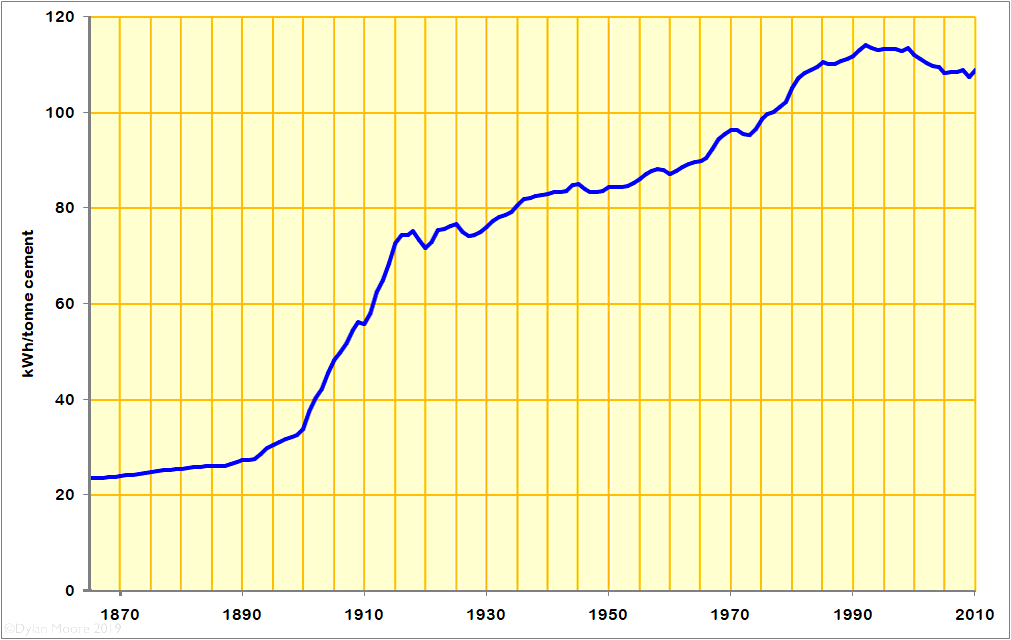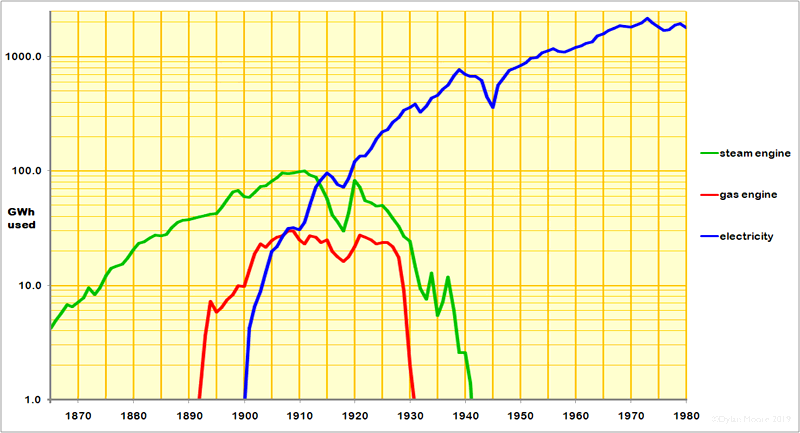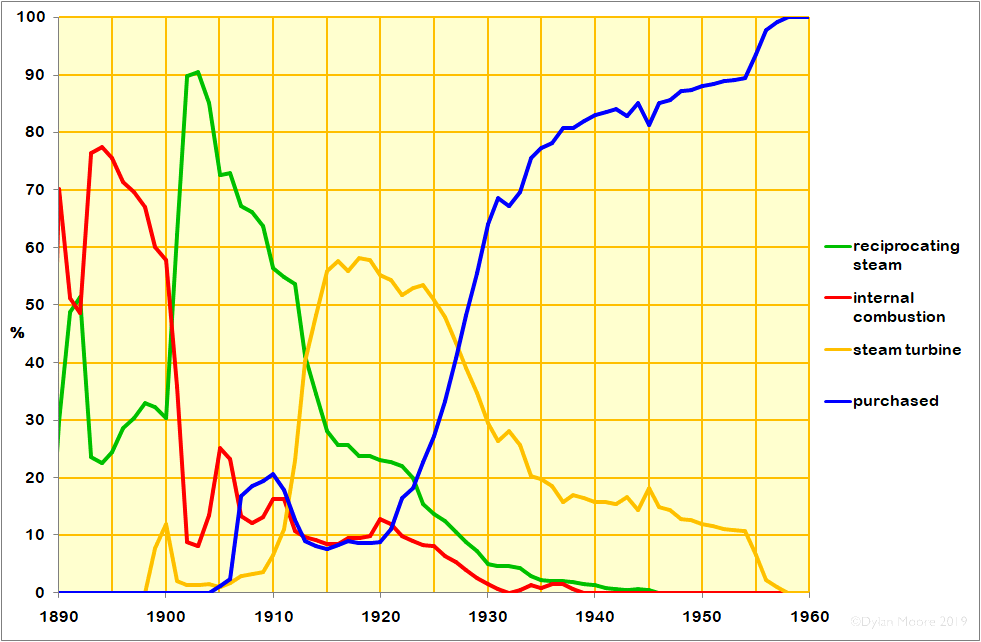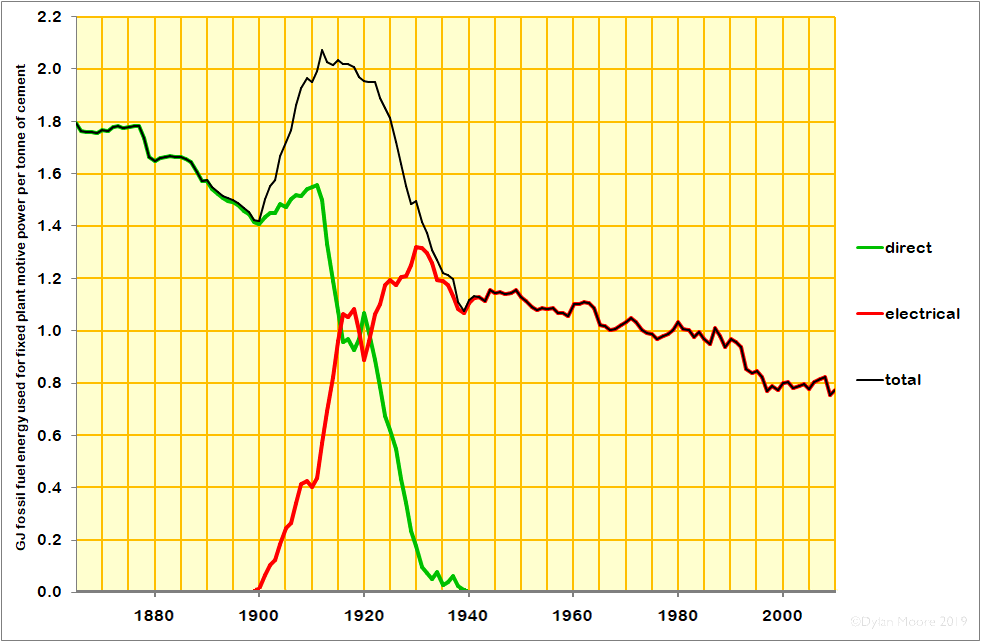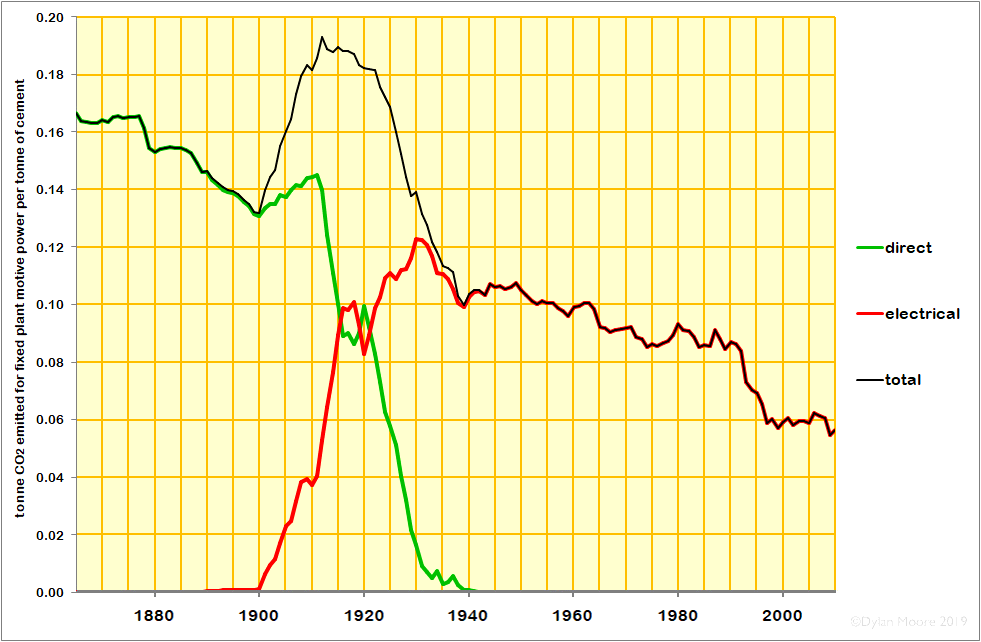The cement industry, in addition to using energy in the form of kiln fuel, also uses energy to drive its processing equipment. The earliest plants making Portland cement already consumed significant amounts of energy in grinding raw materials and clinker. Energy was supplied, typically, by the steam engines of the time, or, occasionally, by wind or water power as was usual in the early Industrial Revolution.
As the industry developed, the energy consumption increased as it did in every industry; there was a need for more intense and sophisticated processing, and, in Britain particularly, energy was cheap, so all innovations tended to be energy-intensive. I call this the "Saturn Rocket" model (or maybe the "Concorde" model). The working principle is as follows:
There is no hitherto-intractable engineering problem that can't ultimately be solved by throwing more energy at it.
Specific energy consumption for motive power of fixed plant in kWh per tonne of cement ground.
A large database of energy data has been compiled. It allows the derivation of reasonably accurate timelines for changes in energy usage. The overall energy consumption of the industry in driving fixed plant is as shown right. Since most such energy nowadays is supplied by electricity, it is given in kWh. 1 kWh = 3.6 MJ, and 100 kWh/t = 0.36 MJ/kg. The features of the curve are:
- An initial low energy associated with use of soft chalk in a thin slurry, with coarse grinding of cement, and most operations using manual labour.
- An increasing market-driven trend towards finer cement, and adoption of ball mills, requiring increased energy from 1870 to 1920.
- Introduction of rotary kilns from 1900, requiring motive energy in the burning stage, which was previously largely manual.
- The increased use of harder raw materials as the industry left the soft chalk areas.
- From 1920 onward, multiple stages of elaboration of the rotary kiln processes - longer kilns, chains, fans, precipitators, preheaters etc, all requiring more power.
- Further market demand for finer product from 1960 onward.
- Finally a drop as high energy prices enforce adoption of more efficient grinding processes.
It should be understood that the energy shown is the energy supplied as torque to the equipment drive. This may be essentially the same as electricity consumption for electric drives, but where power was supplied by thermal engines, their efficiency was low, and the fuel energy input to them was much larger.
In A Hundred Years of Portland Cement: 1824-1924, A. C. Davis, comparing old and new practices, said (p 223):
Whereas at the earlier date (1886) power was provided by curious old steam engines working at something above atmospheric pressure and consuming almost as many pounds of coal per HP-hour as their successors consume of steam, nowadays a cement works rightly thinks itself behind the times if it is not equipped with the most modern form of engine. One says "engine" because the best form ultimately to be adopted has yet to be settled.
Usually the cement-maker has been content with compound or triple-expansion reciprocating steam engines, but he is passing easily to the use of large gas engines or of Diesel oil engines and steam turbines. Whatever the outcome, it is certain that in a modern works a modern power plant must be adopted, because the cost of power is a substantial portion of the whole cost of cement manufacture and the margin of profit is not so great as to permit of any but the best appliances.
Over 38 years, the supply of power had changed vastly, and was still changing. While Davis acknowledged that power would be distributed around the plant by home-generated electricity, the use of electricity bought from a public supply was in 1924 still a novelty apparently not worth a mention. But in little over half a century, power supply changed utterly
Steam Engines
At the start of the industry in the 1840s, apart from rare cases of "renewable" energy such as the tidal mills at Robins and Vectis, power supply consisted of simple steam engines fed by low pressure boilers. The thermal efficiency of these (calorific value of fuel burned converting to "brake horse power") was rarely better than 5% and could be much lower. There was, of course, constant research aiming at improving engine efficiency during the second half of the nineteenth century. This involved the use of ever-increasing boiler pressures (with corresponding increase in the temperature drop across the system that defines the maximum theoretical efficiency), re-use of the partially-expanded steam in double- or triple expansion engines, superheating the steam and recycling of exhaust energy in economisers. These could have thermal efficiencies of 10% or more. However, it was (and probably remains) a characteristic of the cement industry that all but the most profitable plants simply could not afford to buy the latest equipment as soon as it became available; if the old engine was still turning, then it would be nursed along until it fell apart. For this reason, the "curious old steam engines" alluded to by Davis were still a common feature of the industry well into the 20th century. Many are listed in the plant schedules produced in the year of publication of Davis' book. In general, the latest generation of engine would only be installed if a major plant up-rate was taking place. The Blue Circle plant schedules of 1924 listed 92 fixed engines, varying from 9 kW to 1500 kW, average 272 kW. The major suppliers were Pollitt & Wigzell (23% of capacity) and Hick Hargreaves (22%).
Gas Engines
Gas engines are internal combustion engines fuelled by a flammable gas such as coal gas, producer gas or blast furnace gas. They first became available in Britain around 1877, but the early models were too small to be of interest in the cement industry. Engines of sufficient size were available from around 1890 for small duties: they were particularly of interest for driving the small generators for the small-scale electricity projects of the time. Around the turn of the century, large numbers of engines were installed. A key incentive was the thermal efficiency of 15% or more. In the cement industry, the most common fuel was producer gas/water gas, often supplied by automatic suction producers directly attached to the engine, so the unit was effectively fuelled with the coke or coal readily available on the plant. A relative disadvantage of gas engines was their higher maintenance requirement. They needed de-coking fairly frequently, and serious installations had at least three, of which one was expected to be down for maintenance at any time. In the 1924 schedules, 51 engines are listed, with power varying from 15 kW up to 560 kW (at Sundon, where gas engines were used exclusively) with an average 194 kW. Premier engines accounted for over half of the total power installed. While most engines had dedicated suction gas producers, at Swanscombe a full-sized central gas works was installed, feeding gas by pipe to multiple engines on the raw and finish mills.
Power Transmissions
A key characteristic of pre-electric systems was the mode of transmission of power from the engine flywheel to the individual pieces of equipment. On early plants, these were few - some sort of rawmill (usually a washmill or pan mill) and a finish mill (usually flat stones). For plant logistic reasons, these were often far apart, so that separate engines were needed to power them. Solid materials were moved around by wheelbarrow, while slurry was usually lifted to a great height by primitive bucket wheels or screws and allowed to flow down fumes to its destination. Gradually, other powered items were introduced: re-grind mills and pumps for slurry, crushers and cement conveyors. The engine usually turned a lay-shaft which extended through the area in which power was needed, then equipment was turned by means of belts and pulleys distributed along the shaft. Individual items could be started and stopped by means of "fast-and-loose" pulleys, which consisted of two similar-sized pulleys adjacent on the shaft, one of which was keyed onto it, and the other was free to spin on it. To start the equipment, the belt was nudged from the "loose" to the "fast" pulley. Work areas could end up as dangerous forests of fast-moving un-guarded belts. Because of the multiple bearings and friction contacts, such systems were a further source of inefficiency. On some plants, a larger central engine was installed, and the plant was designed so that all the driven equipment was clustered around it using multiple lay-shafts. A major deficiency of this system, for both steam and gas engines, was that they were at their most efficient when run at close to their rated capacity, so when only a few items on the shaft were in operation, the engine was less efficient. A steam engine at half-load might be 20% less efficient. Where the load varied greatly, such as the stoppage of the entire plant except rotary kilns over the weekend, it became common to have available a second, smaller engine sized for the lighter load. Gas engines, as with all internal combustion engines, could not be started up under load. They had to be brought up to speed, then the load was applied by gradually engaging a clutch.
Type of power supplied, %.
Total energy supplied to fixed plant: GWh
Electric Power
Electric power was a solution to many of the problems mentioned above. Electric motors could supply power on the spot, at the turn of a switch, which might be local or remote. It also had the advantage of a superior starting torque, which was necessary for many cement plant drives. Electricity, as in domestic applications, was originally installed only to provide light, for which small DC dynamos were installed at many plants. Use for motive power followed the development of suitable motors, which occurred around 1900. Although a few rotary kiln systems were direct-driven by steam or gas engines, most were electrically powered from the outset, and their installation introduced electrification to the plant. For generation, plants initially added generators to their main engine drive shafts. Naturally, this resulted in no improvement in energy efficiency. A few plants installed dedicated steam or gas engines to drive generators. These systems were over-complicated, combining the existing specialised engine operation and maintenance with an extra item of plant, while producing no clear efficiency improvement.
However, during the first decade of the twentieth century, dedicated generators driven by steam turbines became available, and were purchased as a single unit. These, operating at a high steam pressure and super-heat with many-stage energy transfer, could offer thermal efficiency of 25% or more, and for a given power rating occupied much less space. There followed a replacement of the old engine house with a new turbo-geneator house on many large plants. At the same time, the inefficient Lancashire boilers previously used were replaced with tube boilers, often fed with mechanical stokers, leading to a dramatic reduction both in capital and operating costs. The chart shows the temporary emergence of gas engines, and the total supplanting of engines with electricity over three decades. Electricity usage reached 50% around 1914, boosted by the installation of a number of new, large all--electric plants, notably by FLS and Newell. After a brief hiatus in development in the early 1920s, caused by the temporary re-commissioning of old plants, the progress thereafter was rapid, mainly due to wholesale uptake of purchased electricity.
Source of Electricity Used %.
Electricity Generation
The chart shows the method of generating electricity on cement plants. In the first decade of the twentieth century, steam engines driving generators were in the majority, mainly because the large APCM plants with rotary kilns adopted this. However, after 1910, large turbo-generator power houses started to be installed, mainly at the instigation of FLS. These large and efficient facilities enabled complete electrification of their respective plants. The plants that installed central power plants with turbo-generators to electrify the entire plant were as follows:
Despite the efficiency of these installations, which used essentially the same equipment as the best public electricity suppliers, the economy of scale meant that large power stations could offer a lower price per kWh. Such power stations, designed to provide large-scale power for industrial customers, began to be built in the first decade of the twentieth century. Cement plants had to weigh up the price and reliability of such suppliers - keeping an entire on-site power plant as a backup was not an economic proposition. Early power stations were sited in high-demand areas with a small transmission radius. Long-distance transmission developed later and local "grids" (with multiple transmission routes) only developed in the late 1920s. The National Grid, formed by linking up local grids, started in 1938. So rural sites had less chance of finding a supplier. A few plants that were part of larger integrated industrial complexes (Oldbury, Crosfields, Coltness and Wishaw) could obtain electricity generated on the "mother" plant. However, the first independent plant to adopt purchased power was Billingham, supplied from Middlesbrough, in 1907. There were no more until the 1920s, when many plants started to purchase their power, so that 50% of power was purchased by 1928.
Among these, Humber, Holborough, Dunstable, Hope and Oxford were the first green-field plants to be built without on-site power generation. The Yorkshire Electric Power Co. had three large power stations, linked in a loop, and Hope was fed by two separate lines tapping this system at separate points, and so can be considered to be the first to have "grid" power. The Barking power station, which remained Britain's largest, was used to comprehensively electrify the Thames and Medway plants, and the 1926 re-build of Bevans included no on-site generation, as did the 1929 re-build of Swanscombe. Many of the electricity supply schemes - Humber, Harbury, Dunstable, Barnstone, Southam, Chinnor and Hope - had the side-effect of bringing domestic electric power to their respective localities much earlier than in other rural areas.
Fossil fuel combustion energy consumed per unit of useful energy finally used
Fossil fuel combustion energy consumed (GJ) for fixed plant motive power per tonne of cement made
Tonnes carbon dioxide emitted for fixed plant motive power per tonne of cement made
Equivalent Thermal Energy
By use of the energy database, it is possible to estimate the thermal energy expended in order to power the industry. To do this, it is necessary to derive a time-series for the thermal energy required per kWh consumed in driving equipment. Identifying the equipment used in each department of each plant for each year of operation, the database yields some interesting results.
The first point to note is that although the motive energy consumption of the early industry was relatively low (as shown above), the extreme inefficiency of the early engines wiped out any advantage. Engine systems burned fuel (invariably coal) to produce heat that was converted into work in the form of torque on a drive shaft. The chart shows the mean thermal energy required to produce the energy finally supplied to the shaft. The blue line shows the ratio for the combination of egines in use at the time, providing energy directly to the shaft. The red line shows the embodied fossil fuel nett combustion energy used to produce electric power, whether purchased or produced in-house. The reciprocal of this ratio is the thermal efficiency. By multiplying the power delivered to each piece of equipment by the appropriate ratio, the associated fuel consumption can be calculated.
The fuel energy consumption to provide motive power started out at close to 2 GJ per tonne of cement because of the low efficiency of early engines, and gradually reduced as efficiencies improved. Around 1900, the sharp increase in energy consumption caused a rapid increase in fuel usage until 1911, when improvements in efficiency again became dominant, in particular with the replacement of steam engines with turbo-generators. Electrification was nearly complete, and efficiency continued to improve up to 1939 with the substitution of purchased electricity for home-generated. From there on, despite an upward trend in plant energy usage, fuel energy consumption continued to diminish because of improvements in generating efficiency and the introduction of non-fossil energy sources.
The emission of carbon dioxide associated with the burning of these fuels closely (but not exactly) parallels the energy profile. Even at their highest, they are small compared with the carbonate dissociation emission (around 0.5) and the the kiln fuel emission (from an early ~1.5 declining to around 0.35 today).
